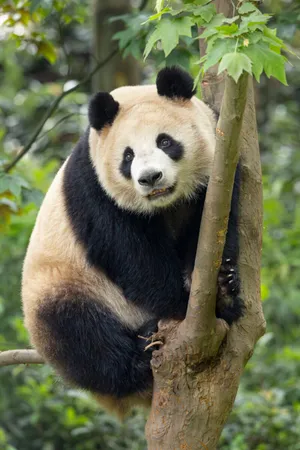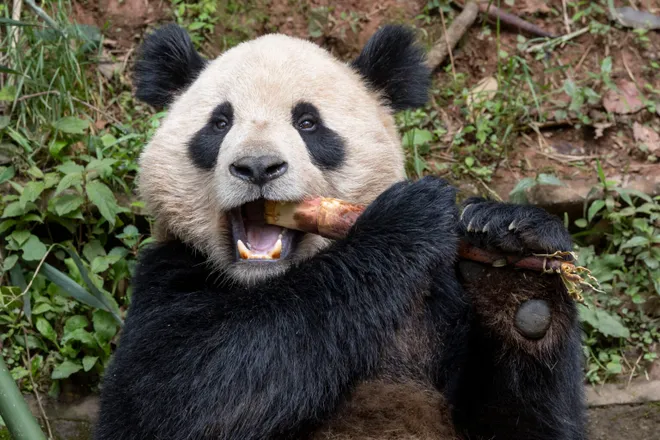Two giant pandas headed to San Diego Zoo: Get to know Xin Bao, Yun Chuan
Two giant pandas are preparing to trek from China to the United States, where they’ll be cared for at the San Diego Zoo.
While their arrival date to the San Diego Zoo has not been confirmed, the San Diego Zoo Wildlife Alliance is working with its U.S. and Chinese conservation partners to hopefully bring them to the U.S. this summer.
The two pandas, Xin Bao (pronounced “sing bao”) and Yun Chuan (pronounced “yoon chu-an”), hail from China as part of a partnership with the China Wildlife Conservation Association, the San Diego Zoo said on its website. Staff met the giant pandas, as well as the people caring for them at the Wolong and Bifengxia Panda Bases in China.
“Our conservation partners in China shared photographs and personality traits of Yun Chuan and Xin Bao, but meeting them in person was so special," Dr. Megan Owen, vice president of conservation science at San Diego Zoo Wildlife Alliance, said in a news release. "It’s inspiring as people from around the world come together to conserve, protect, and care for these special bears, and we can’t wait to welcome them to San Diego."
Meet Xin Bao
One of the zoo’s new arrivals is 3-year-old Xin Bao, a female who will soon turn 4 years old. Her name means “new treasure of prosperity and abundance,” the zoo said.
“Giant pandas often symbolize wildlife conservation, peace, and friendship, but her name also reminds us that in Chinese culture, pandas also symbolize blessings and success,” the zoo said. “Her name will no doubt remind us that it’s an honor to play a part in her success and to help giant pandas thrive, both here and in China.’
The zoo said she is very active, alert, witty and a superb climber. She’s playful and will sometimes roughhouse with other pandas.
According to the zoo, guests may be able to spot Xin Bao pretty easily due to her large, round face and big ears that give her a unique look.

And don't forget Yun Chuan
In addition to Xin Bao, the zoo is welcoming Yun Chuan, who is almost 5 years old.
The first part of his name, “Yun,” means cloud in Chinese. The second part of his name, "Chuan," means big river and alludes to the place where he’s from, Sichuan.
Altogether, his name means “big river of cloud,” a reminder of the “flowing clouds that often shroud the forests where giant pandas live in the mountains of southwestern China,” the zoo said.
Yun Chuan has familial ties to the San Diego Zoo. His maternal grandmother, Bai Yun, as well as his grandfather, Gao Gao, both stayed at the San Diego Zoo in the early 2000s. His mother, Zhen Zhen, was born at the zoo in 2007.
“Yun Chuan’s lineage has deep connections to the San Diego Zoo and we’re excited by the prospect of caring for them," said Owen, from the San Diego Zoo Wildlife Alliance.

Wildlife care specialists from the Wolong Shenshuping Panda Base who have worked with him said Yun Chuan is kind, clever and sensitive. He is mild-mannered with other pandas and always lets them go first.
“When he sees a meal has arrived but has not yet spotted wildlife care specialists, he will hum gently to get their attention,” the zoo said.
He’s also a bit of a sleepyhead and takes a while to get up, the zoo said. He loves afternoon naps and sits for a bit to gather himself once he wakes up.
His nickname is “Chuan Chuan” and guests may be able to spot the giant panda by his long, partially pointed nose tip.
A resilient species
For more than 20 years, the International Union for Conservation of Nature considered the giant panda endangered. In September 2016, the agency updated their status to vulnerable thanks to multiple conservation efforts.
“While we do not believe the giant panda is completely safe, our IUCN Red List evaluation highlights how far we have come in panda conservation,” said Ron Swaisgood, director of applied animal ecology at the San Diego Zoo Institute for Conservation Research, at the time.
“This iconic species, which is the poster child of endangered species globally, no longer qualifies as endangered,” Swaisgood said. “All the trends support this conclusion: Habitat is increasing and the population is growing.”
The San Diego Zoo Wildlife Alliance worked with Chinese conservation institutions for nearly 30 years in an attempt to protect and recover giant pandas and bamboo forests.

Some projects the institutions have worked on include developing a giant panda milk formula and neonatal conservation techniques that helped increased survival rates for nursery-reared cubs from 5% to 95%, the alliance said in a news release.
"The conservation collaboration between San Diego Zoo Wildlife Association and China Wildlife Conservation Association aims to improve giant panda population health and resilience in some of the smallest and most isolated populations vulnerable to extinction and loss of genetic diversity," the San Diego Zoo Wildlife Alliance said in a news release.
Regarding the zoo’s newest additions, the team said it is thrilled to get to know Yun Chuan and Xin Bao more.
“As our team members continue to spend time with Yun Chuan and Xin Bao in China, we look forward to sharing more of our experiences with you, our allies in conservation,” the zoo said.
Saleen Martin is a reporter on USA TODAY's NOW team. She is from Norfolk, Virginia – the 757. Follow her on Twitter at@SaleenMartin or email her atsdmartin@usatoday.com.
Disclaimer: The copyright of this article belongs to the original author. Reposting this article is solely for the purpose of information dissemination and does not constitute any investment advice. If there is any infringement, please contact us immediately. We will make corrections or deletions as necessary. Thank you.





